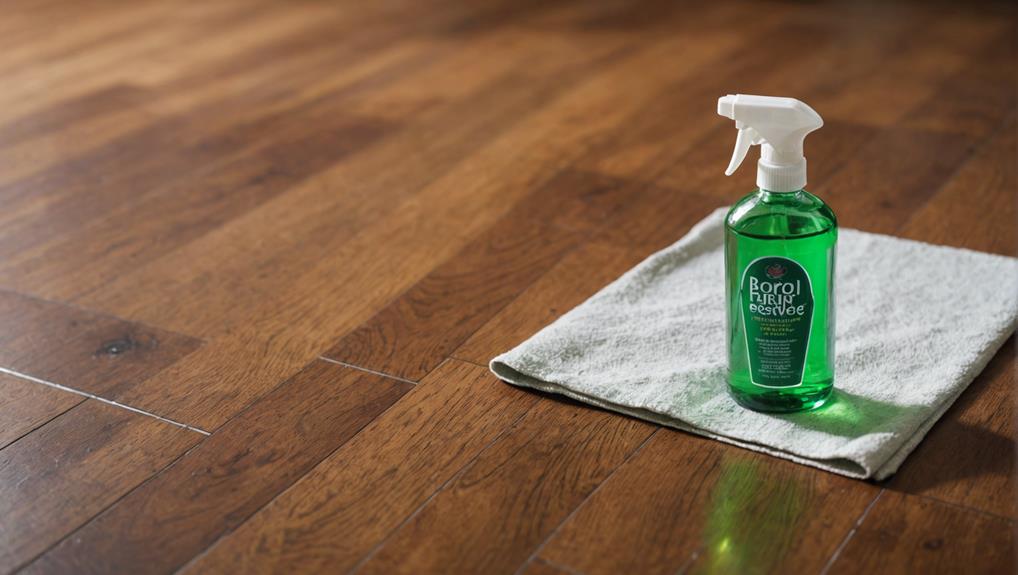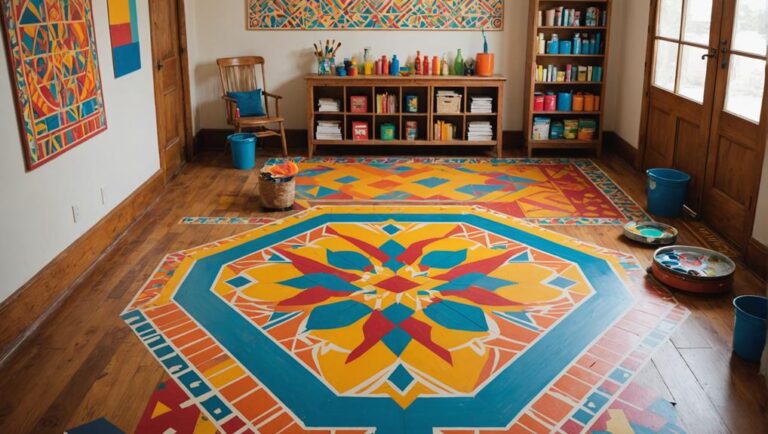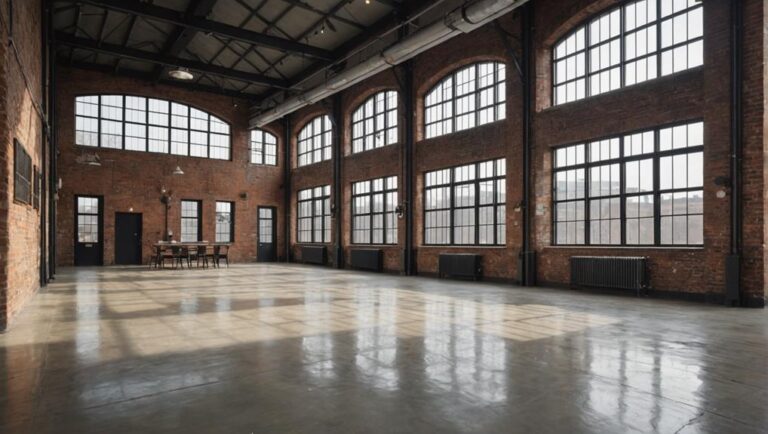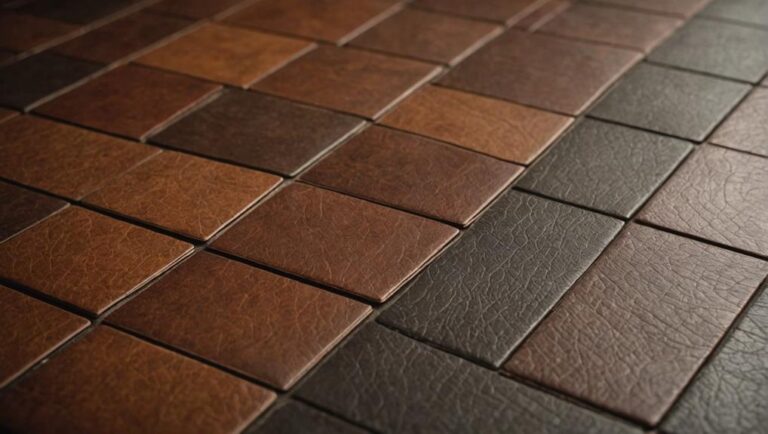To remove stains from resilient flooring, start by identifying the type of stain. For food and beverage marks, gently blot using a mild dish soap solution and warm water, then rinse and dry thoroughly. Ink stains require immediate attention, while grease and paint splatter need prompt cleaning to prevent damage. Utilize soft-bristle brushes and microfiber cloths for effective scrubbing without scratching. Avoid harsh chemicals that can harm your flooring's integrity. To keep your floors looking their best, consider implementing regular maintenance strategies and protective measures, which you can explore further for ideal results.
Understanding Resilient Flooring
Resilient flooring, which includes materials like vinyl, linoleum, and rubber, is designed to be durable and versatile, making it a popular choice for both residential and commercial spaces. These flooring materials offer excellent resistance to wear and tear, moisture, and various chemicals, guaranteeing they can withstand high foot traffic and daily use. However, understanding their unique properties is vital for maintaining their integrity and appearance.
To make certain your resilient flooring remains in peak condition, it is important to follow specific maintenance tips. First, regularly sweep or vacuum the surface to remove dirt and debris that can cause scratches. For deeper cleaning, use a damp mop with a pH-neutral cleaner specifically formulated for your flooring material. Avoid harsh chemicals that could damage the surface or degrade the protective finish.
Additionally, you should promptly address spills and stains to prevent them from setting. Blot the area with a clean cloth and use the appropriate cleaning solution for the specific type of resilient flooring you have. It's also wise to place mats at entry points to reduce the amount of dirt and moisture tracked onto the flooring.
Common Types of Stains
Flooring materials are susceptible to various types of stains that can detract from their appearance and longevity. Understanding the common types of stains that can occur is vital for effective maintenance.
One prevalent issue is ink stains, which can arise from pens, markers, or printer mishaps. Ink spills can be particularly challenging to remove, as they tend to penetrate the surface of resilient flooring. Similarly, paint splatters can occur during home improvement projects, leaving unsightly marks that require prompt attention to avoid permanent damage.
Pet accidents are another common concern, as urine can leave both stains and unpleasant odors if not addressed quickly. It's important to clean these incidents thoroughly to prevent any lingering issues. Grease marks, often from food preparation or mechanical work, also pose a challenge. These stains can be difficult to eliminate without the right approach, as grease can seep into the flooring material.
Additionally, wax residue from candles or furniture can create a sticky surface that attracts dirt and debris. Removing wax requires careful techniques to avoid damaging the flooring.
Basic Cleaning Supplies Needed
Gathering the right cleaning supplies is essential for effectively tackling stains on your flooring. Having the right cleaning tools and stain removers at hand can make the process smoother and safer. Here's a concise list to help you prepare:
| Cleaning Tool | Purpose | Recommended Type |
|---|---|---|
| Microfiber Cloths | Absorb spills and wipe surfaces | Non-abrasive, machine washable |
| Soft-Bristle Brush | Agitate stains without scratching | Gentle bristles, ergonomic grip |
| Bucket | Hold cleaning solutions and water | Sturdy, easy to carry |
| pH-Neutral Cleaner | General cleaning and stain removal | Safe for resilient flooring |
| Vinegar Solution | Natural stain remover and deodorizer | Mix with water for dilution |
| Commercial Stain Remover | Target specific tough stains | Verify it's safe for your flooring type |
Using these tools appropriately will help guarantee you maintain the integrity of your flooring while effectively removing stains. When selecting stain removers, always read the labels to confirm they're suitable for resilient flooring. Avoid harsh chemicals that could damage your flooring.
Additionally, using microfiber cloths prevents scratching while soft-bristle brushes can help lift dirt without harming the surface. Remember to test any cleaning solution in a hidden area before applying it to the stained surface. This helps ensure that it won't cause discoloration or damage. With the right supplies, you're well on your way to restoring your flooring to its original beauty.
Quick Clean-Up Techniques
Often, quick clean-up techniques can make a significant difference in maintaining your flooring's appearance and longevity. When spills occur, immediate action is essential for effective stain removal. Begin by blotting the affected area with a clean, dry cloth to absorb excess liquid. Avoid rubbing, as this can spread the stain and damage the flooring.
For light stains, a mixture of warm water and a few drops of mild dish soap can be effective. Dampen a cloth with this solution and gently wipe the stained area. Rinse with clean water and dry thoroughly to prevent moisture damage. If you encounter tougher stains, a dedicated resilient floor cleaner may be necessary. Always test any cleaner in an inconspicuous area first to verify it won't harm the finish.
Maintaining an appropriate cleaning frequency is important. Regularly sweeping or vacuuming your flooring helps prevent dirt buildup that can lead to stains. Establish a routine that includes cleaning high-traffic areas more frequently to mitigate potential issues. For best results, aim for a weekly cleaning schedule, adjusting as necessary based on your household's activity level.
Remember that prevention is key. Consider placing mats or rugs in entryways to catch dirt and moisture before it reaches your flooring. With consistent quick clean-up techniques and a mindful approach to cleaning frequency, you can keep your resilient flooring looking its best while prolonging its lifespan.
Removing Food and Beverage Stains
Even with diligent quick clean-up techniques, food and beverage stains can occasionally occur, posing a challenge to maintaining your flooring's appearance. When faced with these stains, it's crucial to act promptly and use the right methods to guarantee effective food stain removal while prioritizing the safety of your flooring.
Here's a step-by-step approach to tackle food and beverage stains:
- Blot the Stain: Use a clean cloth or paper towel to blot the stain gently, avoiding any rubbing, as this may spread the stain further. Working from the outer edges inward minimizes damage.
- Prepare a Cleaning Solution: Mix a solution of warm water and a few drops of mild dish soap. Avoid harsh chemicals that might damage your flooring. For stubborn stains, consider adding white vinegar to the mix, but always test a small area first.
- Apply and Rinse: Dampen a clean cloth with the solution and apply it to the stain. Blot the area until the stain lifts, then rinse with clean water to remove any residue. Dry the area thoroughly to prevent moisture damage.
Tackling Mud and Dirt Marks
When it comes to tackling mud and dirt marks on your flooring, knowing the right cleaning solutions can make all the difference. You'll also want to implement effective prevention tips to minimize future stains. Let's explore both aspects to guarantee your floors remain spotless.
Effective Cleaning Solutions
To effectively tackle mud and dirt marks on your flooring, it is essential to choose the right cleaning solution tailored to the surface material. Opting for natural cleaners not only guarantees safety for your family but also helps maintain the integrity of your resilient flooring. Here are three effective cleaning solutions to take into account:
- Eco-Friendly Options: Vinegar mixed with water (1:1 ratio) serves as an excellent pH-balanced cleaner. It effectively breaks down dirt without harsh chemicals.
- Stain Removers: For tougher marks, a paste of baking soda and water can be applied directly to the stain. Allow it to sit for a few minutes before gently scrubbing with a soft cloth.
- Commercial Cleaners: If you prefer a ready-made solution, look for eco-friendly stain removers. Verify they are designed specifically for your flooring type and check for a neutral pH balance to prevent damage.
Using these solutions not only helps remove mud and dirt marks but also aligns with your commitment to a safe, eco-conscious home. Always test any cleaner in an inconspicuous area before applying it broadly.
Prevention Tips and Tricks
By implementing a few simple strategies, you can considerably reduce the occurrence of mud and dirt marks on your flooring. First, consider using stain-resistant materials when selecting your flooring. These materials are designed to repel dirt and can make maintenance much easier. Additionally, opting for protective coatings can provide an extra layer of defense against stains, ensuring your floors retain their pristine appearance.
Next, establish a no-shoe policy in your home. Encourage family and guests to remove their shoes at the entrance, which can considerably minimize the amount of dirt tracked inside. If possible, place mats both outside and inside your doors to trap dirt before it reaches your flooring.
Regular cleaning is also essential. Sweep or vacuum frequently to remove loose dirt and debris. For high-traffic areas, consider using a microfiber mop that can effectively lift dirt without scratching the surface.
Lastly, keep cleaning supplies readily available. Quick cleanup of spills can prevent stains from setting, protecting your investment. By following these prevention tips, your resilient flooring will remain clean and safe for years to come.
Dealing With Scuff Marks
Scuff marks on your flooring can arise from a variety of everyday activities, like moving furniture or dragging shoes. To effectively remove these marks, it's crucial to use the right cleaning techniques tailored to your floor type. Additionally, implementing prevention tips can help minimize future scuffs and maintain your flooring's appearance.
Common Causes of Scuffs
A variety of factors can lead to unsightly scuff marks on your flooring. Understanding these scuff causes is essential for maintaining the integrity of your floor materials. Here are some common culprits:
- Footwear: Shoes with hard soles or rubber grips can easily create scuff marks, particularly on softer floor materials like vinyl or laminate.
- Furniture: Moving heavy furniture or even sliding chairs can cause significant scuffs. Metal or wooden legs are particularly notorious for leaving marks on resilient surfaces.
- Pet Activity: Pets can contribute to scuffing, especially when they sprint across the floor with their nails. Their playful antics may result in scratches and scuffs, impacting the appearance of your flooring.
Effective Cleaning Techniques
Dealing with scuff marks effectively requires a systematic approach to cleaning that considers the type of flooring and the severity of the marks. First, identify the scuff mark's nature; softer marks may be removed with a damp cloth. For stubborn stains, a mixture of warm water and a few drops of dish soap can be applied. Gently scrub the affected area using a soft-bristle brush or cloth to avoid scratching the surface.
If these methods fail, consider using a specialized floor cleaner designed for your specific flooring type. Always test any cleaning product on an inconspicuous area to verify compatibility. For deeper stains, a commercial stain removal product may be necessary, but make sure it's safe for your flooring material.
Cleaning frequency is important; regularly maintaining your floors can prevent scuff marks from becoming permanent. A weekly cleaning routine can minimize the buildup of dirt and grime, making stain removal more manageable. Remember, the sooner you address scuff marks, the easier they'll be to eliminate. Keeping your flooring clean not only enhances its appearance but also prolongs its lifespan, promoting safety and satisfaction in your living environment.
Prevention Tips and Tricks
While it may seem inevitable to encounter scuff marks on your flooring, adopting preventative measures can greatly reduce their occurrence. Implementing stain resistant treatments is a proactive step that can enhance your flooring's durability. Furthermore, regular maintenance is essential to keeping your flooring looking pristine.
Here are three effective tips to prevent scuff marks:
- Furniture Pads: Place felt pads under furniture legs to minimize friction and prevent scratches and scuffs. Regularly check these pads to verify they remain intact.
- Footwear Caution: Encourage family members and guests to remove shoes upon entering your home. Shoes with hard soles can easily leave marks on resilient flooring.
- Regular Cleaning: Sweep or vacuum your floors regularly to remove dirt and debris that can cause scratches. Using a damp mop with a pH-neutral cleaner will help maintain the finish and prevent scuff marks.
Deep Cleaning Methods
Effective deep cleaning methods are essential for maintaining the integrity and appearance of your flooring. Among the most efficient techniques, steam cleaning stands out as a powerful option. This method uses high-temperature steam to eliminate dirt and grime without harsh chemicals, making it safe for both your flooring and the environment.
If you prefer a more DIY approach, a vinegar solution can be effective. Mix equal parts of white vinegar and water to create a natural cleaner. This solution can tackle minor stains and odors effectively. For tougher stains, consider using baking soda as a gentle abrasive. Sprinkle it on the affected area, let it sit, and then scrub with a microfiber cloth or a soft scrub brush.
For persistent stains, enzyme cleaners are worth exploring. These specialized products break down organic materials, making them particularly useful for food and pet stains. Always follow the manufacturer's instructions for safe application.
If your flooring requires a more thorough treatment or if you're unsure about the process, don't hesitate to seek professional services. Experts can provide advanced techniques, including the application of floor polish that enhances the shine and protects against future stains.
Lastly, always use microfiber cloths for regular maintenance, as they are effective in trapping dust and dirt without damaging the surface. By implementing these deep cleaning methods, you can guarantee your resilient flooring remains in top condition, extending its lifespan and maintaining its aesthetic appeal.
Preventative Care Tips
Maintaining your flooring's appearance and durability goes beyond deep cleaning; preventative care plays an essential role in minimizing stains and damage. By incorporating routine maintenance and protective coatings, you can effectively prolong the life of your resilient flooring. Here are some essential tips to keep in mind:
- Regular Cleaning: Sweep or vacuum your floors at least once a week to remove dirt and dust that can scratch the surface. Use a damp mop with a pH-neutral cleaner to avoid damaging the finish and to remove any lingering grime.
- Use Protective Coatings: Applying a high-quality protective coating can shield your flooring from spills and stains. Check with the manufacturer for suitable products and reapply as recommended to maintain the protective barrier.
- Implement Area Rugs: Place area rugs in high-traffic zones or under furniture to reduce wear and tear. Make sure the rugs have a non-slip backing to prevent accidents and protect your flooring from scratches caused by furniture movement.
Frequently Asked Questions
Can I Use Bleach on Resilient Flooring Stains?
It's not recommended to use bleach on resilient flooring stains, as it can damage the surface and lead to discoloration. Instead, consider bleach alternatives like vinegar or baking soda, which are safer and effective for stain removal. To prevent future stains, regularly clean your flooring and promptly address spills. This proactive approach not only maintains the appearance of your flooring but also extends its lifespan, ensuring a safer environment for your home.
How Often Should I Deep Clean Resilient Flooring?
In the grand tapestry of home care, deep cleaning frequency for resilient flooring should ideally be every 1-3 months, depending on foot traffic and usage. Regular floor maintenance tips include sweeping daily and mopping weekly to prevent dirt accumulation. This schedule not only prolongs the lifespan of your flooring but also safeguards your health by reducing allergens. Always consult manufacturer guidelines for best practices to guarantee safety and peak results in your cleaning routine.
Are There Specific Tools for Cleaning Resilient Floors?
When it comes to cleaning resilient floors, using the right tools is crucial. You'll want microfiber mops and soft-bristle brooms for effective dirt removal without scratching. For cleaning products, opt for pH-neutral solutions that won't harm the surface. Additionally, consider applying a protective sealant to enhance stain prevention. Always follow manufacturer guidelines to guarantee safety and maintain the integrity of your flooring while keeping it looking pristine and well-maintained.
Can I Use a Steam Cleaner on Resilient Flooring?
You can use a steam cleaner on resilient flooring, but it's essential to check the manufacturer's guidelines first. Steam cleaning benefits include effective sanitization and dirt removal without harsh chemicals. However, excessive moisture can damage some resilient floors, so make sure you're using the right settings. For ideal resilient floor care, keep the steam cleaner moving and avoid prolonged exposure to prevent water damage or warping. Always prioritize safety and floor longevity in your cleaning routine.
What Should I Do if Stains Persist After Cleaning?
Did you know that about 80% of stains can be removed with proper techniques? If stains persist after your initial cleaning, consider advanced stain removal techniques like enzymatic cleaners or gentle scrubbing with a soft brush. For persistent stain solutions, you might need to let the cleaner sit longer or repeat the process. Always test any product on a small, inconspicuous area first to guarantee it won't damage your flooring.




